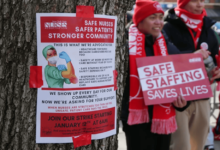Trusts looking to cut clinical staff to save money

Nurse leaders have warned against “dangerous” plans to cut clinical staff numbers in order to meet NHS cost targets, arguing that it could put patient lives at risk.
It comes as two thirds of NHS trust leaders have said they are planning to cut clinical staff numbers to reduce their spending, according to a new survey by the NHS Confederation.
“The evidence is clear that when you cut nursing staff patients die”
Patricia Marquis
The survey of 110 leaders working across NHS trusts, integrated care boards (ICBs) and primary care providers laid bare the organisational struggle to ‘balance the books’ while protecting patient safety.
The survey, carried out between late April and early May this year, revealed that organisations were trapped in a cycle of “short-termism” where immediate cuts to meet financial targets are being prioritised over long-term plans to improve services.
It found that many NHS organisations were having to meet high efficiency targets of 5% and above – with some as high as 11% – meaning this is the tightest financial position trusts have faced in years.
It comes as the chancellor Jeremy Hunt this year gave the NHS an additional £2.4bn in revenue funding, against a backdrop where industrial action had already cost the NHS around £3bn in total.
More than six in 10 (61%) respondents to the survey said they would need top-up funding from the government within the year to have a chance of hitting the efficiency targets.
One NHS trust chair said: “Our financial position is really difficult.
“We’re expected to make very substantial efficiency savings, larger than the NHS has ever achieved, at the same time as facing extraordinary levels of demand.”
Meanwhile, another NHS trust chief executive added: “I do not believe that it is possible for us to deliver all our financial, performance, workforce and quality/safety requirements next year – something has to give.”
As such, NHS leaders have said they will have to make cuts to balance the books.
Some 67% of NHS trusts and ICBs plan on reducing clinical staff to meet their efficiency targets, while 90% plan to reduce non-clinical staff too.
Similar figures can be seen in primary care, with 75% planning to reduce clinical staff and 79% reducing non-clinical staff.
The proposed staff decreases have come while the NHS Long Term Workforce Plan has committed to increasing the total number of NHS staff.
The plan has promised to increase the number of nurse training places by 80% to 53,858 by 2031-32.
Separately, the NHS Confederation survey revealed that 56% of respondents planned to reduce spending on agency and bank staff, while 39% planned to freeze vacancies.
The Royal College of Nursing’s executive director for England, Patricia Marquis, warned against the proposed cuts to clinical staff.
She said: “The evidence is clear that when you cut nursing staff patients die.
“These unbelievable plans highlight a dangerous disconnect between government rhetoric and the reality for NHS staff.
“Health leaders have a duty to deliver safe patient care and that must be prioritised over meeting government financial targets.”

Patricia Marquis
Ms Marquis warned that the NHS already did not have enough staff to meet patient demand and that it was “incredibly dangerous to make matters worse”.
She added: “The millions that are stuck on waiting lists are proof that balancing the books on the backs of patients is a road to nowhere.
“Cuts to services harm patient outcomes and cost the NHS more in the long run.
“We need urgent support from government to NHS trusts – these cuts cannot be allowed to happen.”
The NHS Confederation said trust leaders wanted the main political parties to safeguard local NHS organisations from having to further freeze or cut clinical and non-clinical posts.
It said the next government, the colour of which will be decided in the next five weeks at the general election, must ensure that the NHS has the resources it needs.
Health leaders wish to see an additional £6.4bn of capital investment, commitment to fund the implementation of the NHS Long Term Workforce Plan and a similar workforce plan being published for social care.
Matthew Taylor, chief executive of the NHS Confederation said: “The NHS is operating under immense financial strain, with some local services already cutting or freezing clinical and managerial posts, as well as cutting some patient services.

Matthew Taylor
“They are facing up to some drastic measures to balance their books this year.
“While NHS leaders know they must continue to run their services as efficiently as possible, this is the tightest financial position the NHS has faced in years.”
Also responding to the survey, Unison head of health, Helga Pile, said tackling the mounting pressures on the NHS would be “a major priority for whoever forms the next government”.
“No part of the NHS should be cutting staff when what’s really needed is for many thousands of vacancies to be filled,” she said.
“False economies like these are foolhardy in the extreme.
“There’s little chance of reducing waiting lists and providing better patient care if staff numbers shrink any further.
“Securing a decent pay deal after the election and stabilising the workforce are key to the future of the NHS.”
The Department of Health and Social Care said it was unable to comment due to pre-election communications restrictions.







